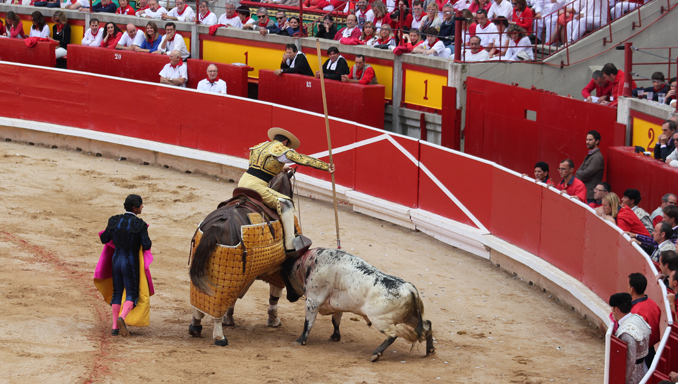Written by: Dr. Dushka H. Saiyid - Posted on: July 28, 2014 |  Comments | 中国 (Chinese)
Comments | 中国 (Chinese)
Google Translation: اُردو | 中文
Pamplona hits the headlines every year in the second week of July as the festival of Sanfermines gets going: the world watches the frenzy of the runners and then the inevitable news of the occasional goring of the runners. It only seems to have contributed to the popularity of the festival as tens of thousands of people descend on this small city of about two million for the eight day event, and the prices of everything, especially hotels, shoot up manifold.
It was Hemingway who made bullfighting fashionable in the English-speaking world with his books, The Sun Also Rises, and Death in the Afternoon, and put Pamplona firmly on the tourist map. What must have been an interesting and colourful fiesta in Hemingway’s time has become a manic, touristy, overcrowded and moneymaking frenzy of eight days. But the festival has its charm and thrills, especially for the young: the crowds come all dressed in white with red sashes around their waists, or a red scarf tied around the neck, and it’s party time all over the city.
The mayor inaugurates the fiesta from the balcony of the town hall on July 6 with the firing of a rocket, music pours from every corner and crowds throng the streets, going through gallons of beer or sangria.
The next morning was the first day of the running of the bulls. The original idea was to herd the bulls from their pens to the Plaza de Toros, which was on the other side of the town. We paid to watch the spectacle from the balcony on Calle de Estafeta, the route of the encierro, as the bull run is called. At 8 am sharp, a gunshot is heard, and the bulls are let lose, accompanied by thousands of runners, and within five or six minutes there is another shot, announcing that the bulls have reached the Plaza de Toros. The popularity of the event can be gauged from the fact that on our balcony there were people from Australia, the USA and Wales, but by the next day, half of these people felt inspired to participate in the bull run. The run was not uneventful; one young man had been gored, although he survived. The rest of the week saw more casualties, but the enthusiasm of the runners remained unabated.
The bullfight itself, later in the evening, was a festive event full of pageantry and drama. People had come with families and friends. At 6.30 sharp the three matadors, accompanied by their assistants, the banderilleros, and the picadors marched into the ring to the accompanying traditional music. Once the chief guest gives the signal, the bull is let out and comes running into the arena to roars of the crowd. The picadors on their horses are waiting for him and pierce his back with their lances and the bull attacks the horse, whose body is a nowadays protected by some kind of armour. The matador, slim, nimble footed, dressed in a tight fitting outfit heavily embroidered in gold, then distracts the bull by waving the bright pink cape and making passes and maneuvers close to the horns of the bull, who weighs more than 460 kg. The bull attacks the moving cloth, and the closer the matador gets to the bull as he makes the passes, the greater the roar of approval from the crowd. As if the picadors had not bled the bull enough, the banderilleros move forward with brightly coloured banderillas or pointed sticks and plant them in the bull’s shoulders.
 |
Amongst the many passes that the matador makes, the trincherazo is the most dramatic and dangerous, because the matador leans on the ground on one knee and makes the pass, making the bull go around him with just inches away, chasing the cape. Eventually, the matador takes the sword out of the muleta and thrusts it between the shoulder blades of the bull while hurtling over its horns, another very dangerous manouver. The roar of the crowd goes up as the deed is done. Much weakened, the bull collapses on its all fours, and the final cuts are delivered by one of the bandilleros carrying special knives, which are then thrust to its head, and the bull rolls over, the crowd roars with approval and the matador takes his bows.
A local lady sitting in front of us kept toasting her glass of wine with each cut to the bull. It was reminiscent of the Roman gladiatorial fights, only the bulls had replaced the humans. We left after just two bullfights, although our tickets entitled us to four more, for the amazing skill, grace and courage of the matadors could not make up for the slow and painful death inflicted on the bull.
Click to view picture gallery